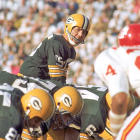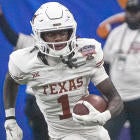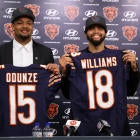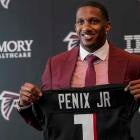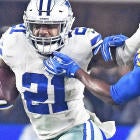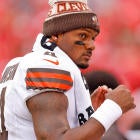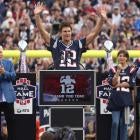
No NFL franchise can match the tradition that lies in Green Bay, Wisconsin.
One of the NFL's original franchises, the Packers have won a record 13 championships, which is why the city of Green Bay is traditionally referred to as "Titletown." The Packers have had four different championship eras, from Curley Lambeau (six championships from 1929-44) to Vince Lombardi (five championships in the 1960s) to Brett Favre/Mike Holmgren (two NFC titles and a Super Bowl win in the '90s) to the success Aaron Rogers/Mike McCarthy enjoyed in the 2010s. Over the decades, the Packers have established themselves as NFL royalty, a legacy they will look to continue as the franchise begins its second century of existence.
Before the Packers begin their 101st season, we decided to construct a 53-man roster consisting of some of the franchise's all-time great players. The roster was constructed the way modern teams build their rosters, which is why we weren't able to include every great player in Packers' history. The position that will surely generate the most attention is at quarterback, where the Packers already have two Hall of Fame players and a future Hall of Famer in Aaron Rodgers. Here's how I came up with my depth chart as it relates to the quarterback position.
- Bart Starr over Brett Favre and Aaron Rodgers: While Favre and Rodgers are legends in their own right, the standard bearer for great Packers quarterbacks is Starr, the MVP of Super Bowls I and II and the last quarterback to lead his team to three consecutive NFL titles. A five-time champion, Starr is also the architect of one of the most legendary drives in NFL history, as he led the Packers through the Cowboys' vaunted defense before scoring the game-winning touchdown in the legendary '67 Ice Bowl.
- Favre over Rodgers on the depth chart: Rodgers is still writing his football legacy, so that hurts his case when comparing his career to Favre's, one of the most accomplished players in league history. And while Rodgers' current career achievements are already Canton worthy, Favre's 11 Pro Bowl selections, three consecutive MVP awards, two passing titles (along with leading the league in touchdown passes four times) and 297 consecutive starts is hard to top. Favre and Rodgers do have very similar postseason marks, which means that, if Rodgers is able to lead the Packers to another Super Bowl win, he would likely move ahead of Favre on the depth chart when he does decide to call it a career.
Now that the quarterback position has been examined, here's a look at the rest of the Packers' all-time, 53-man roster, along with some analysis behind some of the selections.
* denotes players that are members of the Pro Football Hall of Fame
Offense
| Starter | Backup | Depth | |
|---|---|---|---|
QB | Bart Starr* | Brett Favre* | Aaron Rodgers |
RB | Paul Hornung* | Ahman Green | Dorsey Levens |
FB | Jim Taylor* | ||
WR | Don Hutson* | Donald Driver | |
WR | James Lofton* | ||
SWR | Sterling Sharpe | Jordy Nelson | Donald Driver |
TE | Paul Coffman | Bubba Franks | |
LT | Chad Clifton | ||
LG | Mike Michalske* | Fred "Fuzzy" Thurston | |
C | Jim Ringo* | Frank Winters | |
RG | Jerry Kramer* | Gale Gillingham | |
RT | Forrest Gregg* |
Ahman Green is the Packers' all-time career rushing leader, which secured him a spot on the roster. Behind him is Dorsey Levens, whose contributions on one Super Bowl champion and two NFC championship teams could not be ignored. Jim Taylor, the franchise's career leader with 81 touchdown runs, was an easy pick as the team's all-time fullback. Taylor enjoyed a successful partnership in Green Bay with Paul Hornung, who paced the NFL in touchdown runs in 1960. The next season, Hornung put up an All-Pro season while helping lead the Packers to their first championship under Lombardi.
There were a slew of deserving receivers that just missed the cut. Two former wideouts that missed the cut were Boyd Dowler and Max McGee, two of Starr's favorite targets during the '60s. But the toughest roster cut here was Antonio Freeman, who played a large role on two Packers' Super Bowl runs (he particularly played big in Super Bowls XXXI and XXXII, catching a combined 12 passes for 241 yards and three touchdowns). But when you have a receiving room that consists of two Hall of Famers (Don Hutson and James Lofton), a should-be Hall of Famer (Sterling Sharpe) as well as the franchise's career leader in receptions and receiving yards (Donald Driver), you have to draw the line somewhere. The "bubble" receiver that was able to make the cut was Jordy Nelson, a key player on the Packers' 2010 title team who enjoyed more career longevity than Freeman. Nelson's nine catch, 141-yard, one-touchdown effort helped Rodgers earn MVP honors in Super Bowl XLV.
An eight-time Pro Bowler, Lofton led the NFL in yards per catch in consecutive years during the early '80s. Sharpe, a five-time Pro Bowler and three-time All-Pro, would have a gold jacket if not for his career-ending injury at just 29 years old. Making Sharpe's injury more painful was the fact that he was only three years into his time with Favre, who helped Sharpe lead the NFL in receptions twice as well as in receiving yards in 1993. Five years after Sharpe's final down as a Packer, the Packers drafted Driver, who would serve as Favre's favorite target during the second half of his career in Green Bay. Driver, who was also a 1,000-yard receiver for Rodgers, called it quits a year after winning his ring at the end of the 2010 season.
As good as these receivers were, the leader of the Packers' receiving corps is Hutson, who was the NFL's best receiver during the league's first half century. An eight-time All-Pro, Hutson led the league in touchdown receptions nine times and in receiving yards nine times. Hutson's All-Pro season in 1944 helped the Packers win their sixth and final title with Lambeau as their head coach.
Green Bay's offensive line is another unit that is decorated with bronze busts, with four Hall of Famers making up the starting five. Ringo, Kramer and Gregg were members of the Packers' famed 1960s offensive line, a unit that made the Packers' nearly unstoppable. Michalske was a valued member of the first Packers team that won three straight titles from 1929-31. Green Bay's more recent offensive line units are represented by Clifton, Bakhtiari and Bulaga. Gillingham, Thurston (two more members of the Packers' '60s offensive line) and Winters (Favre's center during the team's 1990s championship runs) round out the Packers' offensive line.
Defense
| Starter | Backup | Depth | |
|---|---|---|---|
LDE | Reggie White* | Ezra Johnson | |
LDT | Gilbert Brown | Ron Kostelnik | |
RDT | Henry Jordan* | Dave Hanner | |
RDE | Willie Davis* | Kabeer Gbaja-Biamila | |
OLB | Dave Robinson* | ||
MLB | Ray Nitschke* | Nick Barnett | |
MLB | Fred Carr | A.J. Hawk | |
OLB | Bill Forester | John Anderson | |
RCB | |||
LCB | Herb Adderley* | Willie Buchanan | |
SS | LeRoy Butler | Johnny Gray | |
FS | Willie Wood* | Bobby Dillon* | Dun Hutson |
I challenge you to find a better starting defensive end duo than the Packers' duo of Reggie White and Willie Davis. White, whose three second-half sacks of Drew Bledsoe helped the Packers shut out the Patriots during the fourth quarter of Super Bowl XXXI, is second all-time with 198 career sacks. Davis, a member of all five of the Packers' championship teams during the '60s, was an All-Pro each season from 1964-67. Behind this powerful duo is longtime is Kabeer Gbaja-Biamila, whose 74.5 career sacks is second all-time in Packers history. Hall of Famer Henry Jordan spearheads a defensive interior that includes two members of Green Bay's '60s dynasty (Dave Hanner and Ron Kostelnik) as well as Gilbert Brown, a massive defender who helped Green Bay win it all in 1996.
Green Bay's starting linebackers consist of two more cornerstones from the '60s dynasty in Ray Nitschke and Dave Robinson. Robinson's disruption of the Cowboys' final play in the '66 NFL title game helped clinch the Packers' first Super Bowl ticket. Nitschke, one of the leaders of Green Bay's formidable defense, spent the decade battling with Chicago's Dick Butkus for the unofficial title of the league's most intimidating defender. The team's linebacker corps also includes Clay Matthews (the franchise's all-time leader in career sacks), former teammates A.J. Hawk and Nick Barnett, and Bill Forester, who toiled on some bad Packers teams during he '50s before winning two championships with the Packers at the start of the '60s. The group also includes John Anderson -- a member of the NFL's All-Decade team for the 1980s -- and Tim Harris, whose 19.5 sacks in 1989 remains a Packers' single season record.
The Packers' secondary oozes of talent. The unit includes three Hall of Famers in Willie Wood, Herb Adderley and Bobby Dillon, a 2020 Hall of Fame finalist in LeRoy Butler and a soon-to-be Hall of Fame eligible Charles Woodson. The group also includes Hutson, who picked off 30 passes (that included a league-high six picks in 1940) while playing safety during his final six seasons in Green Bay. Wood and Adderley both made big plays that helped the Packers win the first two Super Bowls with ease, while Woodson and Butler played influential roles on Green Bay's two most recent title teams.
Perhaps the biggest defensive player omitted from the roster is former free safety Nick Collins, a three-time Pro Bowler who led the league with three interception returns for touchdowns in 2008. Collins' pick-six of Pittsburgh quarterback Ben Roethlisberger helped the Packers defeat the Steelers in Super Bowl XLV.
Special Teams
| Starter | Depth | |
|---|---|---|
K | ||
P | ||
LS | ||
KR | Desmond Howard | Herb Adderley* |
PR | Desmond Howard | Charles Woodson* |
Green Bay's kicker since the 2007 season, Mason Crosby has made 81% of his field goal attempts and 98% of his point-after attempts. Tim Masthay, the team's punter from 2010-15, averaged 44.2 yards per punt during his six years with the Packers.
One of the biggest no-brainers on the Packers' all-time roster was Desmond Howard serving as the team's starting kickoff and punt returner. The MVP of Super Bowl XXXI, Howard, whose 99-yard kickoff return gave the Packers control of the game, returned three punts for scores during the '96 regular season. He returned another punt return for a score in Green Bay's beatdown of the 49ers in the divisional round of the playoffs.













